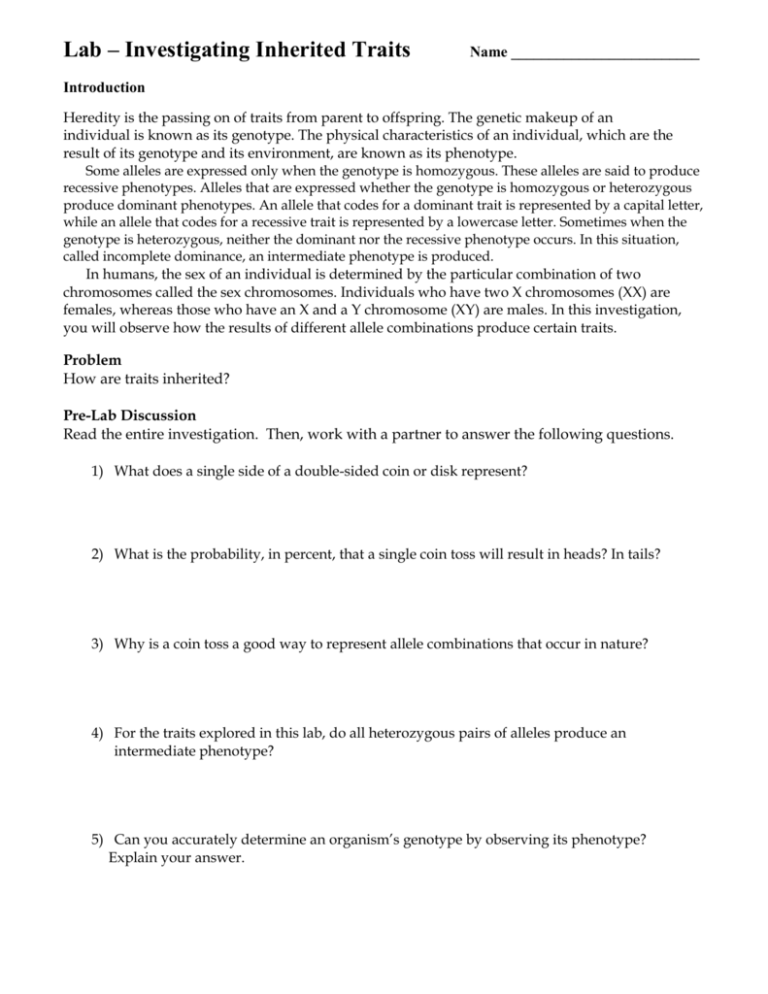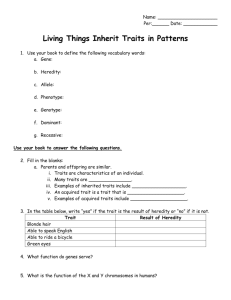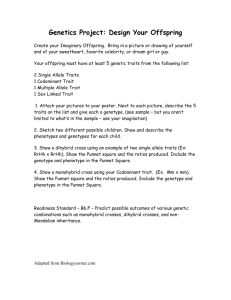Lab - Investigating Inherited traits
advertisement

Lab – Investigating Inherited Traits Name _________________________ Introduction Heredity is the passing on of traits from parent to offspring. The genetic makeup of an individual is known as its genotype. The physical characteristics of an individual, which are the result of its genotype and its environment, are known as its phenotype. Some alleles are expressed only when the genotype is homozygous. These alleles are said to produce recessive phenotypes. Alleles that are expressed whether the genotype is homozygous or heterozygous produce dominant phenotypes. An allele that codes for a dominant trait is represented by a capital letter, while an allele that codes for a recessive trait is represented by a lowercase letter. Sometimes when the genotype is heterozygous, neither the dominant nor the recessive phenotype occurs. In this situation, called incomplete dominance, an intermediate phenotype is produced. In humans, the sex of an individual is determined by the particular combination of two chromosomes called the sex chromosomes. Individuals who have two X chromosomes (XX) are females, whereas those who have an X and a Y chromosome (XY) are males. In this investigation, you will observe how the results of different allele combinations produce certain traits. Problem How are traits inherited? Pre-Lab Discussion Read the entire investigation. Then, work with a partner to answer the following questions. 1) What does a single side of a double-sided coin or disk represent? 2) What is the probability, in percent, that a single coin toss will result in heads? In tails? 3) Why is a coin toss a good way to represent allele combinations that occur in nature? 4) For the traits explored in this lab, do all heterozygous pairs of alleles produce an intermediate phenotype? 5) Can you accurately determine an organism’s genotype by observing its phenotype? Explain your answer. Materials - 2 coins Procedures 1. Have ONE individual flip a coin to determine the gender of the offspring. If the coin lands heads up, the offspring is a female. If the coin lands tails up, the offspring is a male. Record the gender of the offspring in the blank(s) provided above Figure 1. 2. For the remainder of the coin tosses you will now make, heads will represent the dominant allele and tails will represent the recessive allele. 3. You and your partner should now flip your coins to determine the phenotype of the first trait, the shape of the face. Note: The coins should be flipped only once for each trait. 4. Continue to flip the coins for each trait listed in the table in Figure 1. After each flip, record the trait of your offspring by circling the appropriate box in the table. (Note: Some information in Figure 1 has been simplified. Some listed traits are actually produced by two or more genes.) 5. Using the recorded traits, draw the facial features for your 1st offspring in the space below 6. Repeat procedures 1 – 4. With each flip this time you will record the trait of your 2nd offspring by drawing a triangle around the appropriate box in the table. NOTE – you do not need to draw your 2nd offspring. Drawing of 1st Offspring Gender of Figure 1 Offspring #1 _______________ Offspring #2 __________________ Figure 1 continued Analysis and Conclusions 1. Inferring- What are the possible genotypes of the parents of an offspring who has wavy (Hh) hair? 2. Classifying- Which traits in this investigation showed incomplete dominance? 3. What similarities exist between your first and second offspring? What differences? 4. Predicting- Would you predict that another pair of students in your class would have an offspring genetically identical to yours? Support your answer. 5. Drawing Conclusions- Do you think anyone in your class has all the same genetic traits that you have? Explain your answer. 6. Comparing and Contrasting- How is this coin-toss model similar to the way in which traits are inherited in living things? How is the model different? 7. Drawing Conclusions- How might it be possible for you to show a trait when none of your relatives show it?








